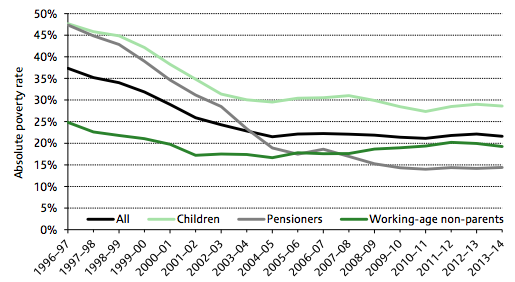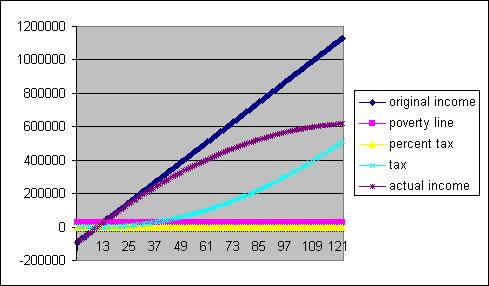Difference Between Relative Poverty and Absolute Poverty
Poverty is an economic state where people are experiencing it lacks certain commodities that are considered essential for the lives of human beings.
Certain regions around the world are considered experiencing poverty at significantly higher levels as compared to other regions.
Relative and absolute are some of the methods used for measuring poverty levels. There are significant differences between relative and absolute poverty that individuals need to understand.

What is Absolute Poverty?
The term absolute poverty is used to refer to the poverty conditions where an individual cannot meet the most basic commodities to sustain life and other normal activities.
This means that any person who is struggling to find food, shelter, and clothing is in absolute poverty.

What is Relative Poverty?
Relative poverty is defined to the standard of living as compared to the economic standards of living for other people within the surrounding.
This means that an individual is considered power concerning the environment or the living conditions of the people he or she is living with.
Difference Between Relative and Absolute Poverty
1) Biological Needs in Relative and Absolute Poverty
The primary differences between absolute and relative poverty are that absolute poverty focuses more on the biological needs while relative poverty has nothing to do with biological needs.
According to the definition of more Absolute poverty, any person who is not in a position to meet the most basic commodities to sustain life like food, shelter, and clothing is considered to experiencing extreme poverty.
On the other hand, relative poverty does not classify biological needs in its definition but focuses on the comparison between other people within the environment.
It is important to highlight that one can be meeting his or her biological needs but still be considered as poor under relative poverty measurement.
2) Income Levels in Relative and Absolute Poverty
The second difference is that the income level is highly considered in absolute poverty, but it is not considered under the relative poverty measurement.
People who have a considerable amount of income can meet their basic commodities, which include food, shelter, and clothing and can even go further to fund their entertainment. However, one may be accomplishing these factors but still be considered poor under the relative poverty model.
This is because other individuals within his or her settings are accomplishing greater life achievements while at the same time getting large amounts of income as compared to his or her outcome.
3) Country Dependency in Relative and Absolute Poverty
Relative poverty varies between developed and developing countries while absolute poverty does not vary.
Some of the western and developed countries have a smaller number of people who are under relative poverty while developing countries, especially those in the African region has a significant number of people under the relative poverty measurement model.
This is not the same for extreme poverty, which has been maintained at a constant by the World Bank. Any individual who lives under $1.90 is considered to be experiencing absolute poverty under the World Bank measurement paradigm.
It is important to highlight that a significant number of populations in Africa live under the highlighted amount.
4) Changes in Relative and Absolute Poverty
The other difference is that absolute poverty can change while relative poverty cannot change.
A government may put measures to ensure that all its population can earn more than $1.90 per day, which will enable them to meet basic commodities like food, clothing, and shelter However, it is very difficult for the government to alleviate all persons above relative poverty.
According to economic experts, there will always exist people with factors of production, which makes them be rich as compared to other population. This means that some people will always be poor as compared to the rich people.
This is the case in the developed countries where some people are rich while others can only meet their basic needs and afford to pay for leisure and entertainment activities.
5) Poverty Alleviation Programs for Relative and Absolute Poverty
Different international bodies and government of various countries have developed policies and measures to ensure that absolute poverty is eradicated around the world, while there are no measures and policies implemented to alleviate relative poverty.
The United Nations has included poverty absolute poverty eradication as one of its sustainable development goals while there is no body concerned with the eradication of relative poverty in the world.
However, it is imperative to highlight that various governments have been developing measures to ensure that at least all the populations in those countries can attain the middle-income status.
6) Quality of Life in Relative and Absolute Poverty
People living in absolute poverty have poor quality lives while those living in relative poverty have quality lives.
Besides, people living under extreme poverty levels cannot access basic commodities in their lives like food and shelter, which makes them highly vulnerable to diseases.
Moreover, the conditions are likely to be dirty with a high level of crime and lacking in medications. This is not the same for people living in relative poverty because they can access various commodities and can meet medication costs.
Difference Between Relative and Absolute Poverty

Summary of Relative vs. Absolute Poverty
- Differentiating between absolute poverty and relative poverty is important for individuals so that they can understand what they are experiencing.
- Poverty alleviating bodies should also understand the difference between absolute and relative poverty so that they can develop suitable programs to deal with the challenge.
- Lastly, poverty is a severe condition that is not acceptable due to its severe impacts on the life of human beings. All individuals should strive to eradicate poverty in the communities.
- Difference Between Gross NPA and Net NPA - April 20, 2018
- Difference Between Job Description and Job Specification - April 13, 2018
- Difference Between Yoga and Power Yoga - April 10, 2018
Search DifferenceBetween.net :
3 Comments
Leave a Response
References :
[0]Foster, James E. "Absolute versus relative poverty." The American Economic Review 88.2 (1998): 335-341.
[1]Moller, Stephanie, et al. "Determinants of relative poverty in advanced capitalist democracies." American Sociological Review (2003): 22-51.
[2]Zheng, Buhong. "Statistical inference for poverty measures with relative poverty lines." Journal of Econometrics 101.2 (2001): 337-356.
[3]Image Credit: https://en.wikipedia.org/wiki/File:Relative_poverty_chart_25000.gif
[4]Image Credit: https://commons.wikimedia.org/wiki/File:Absolute_poverty_rates_(After_Housing_Costs)_in_the_UK,_1997-2014.png#/media/File:Absolute_poverty_rates_(After_Housing_Costs)_in_the_UK,_1997-2014.png

Thanks for this it is really helpful and true
Nice writing
Absolute poverty could be set at a constant real income level, e.g. real income of $500 per year. However, it would have to take into account different living standards between countries. $500 would be insufficient to gain shelter in New York, but maybe in Africa. The UN summit on poverty called for countries to develop their own measure.